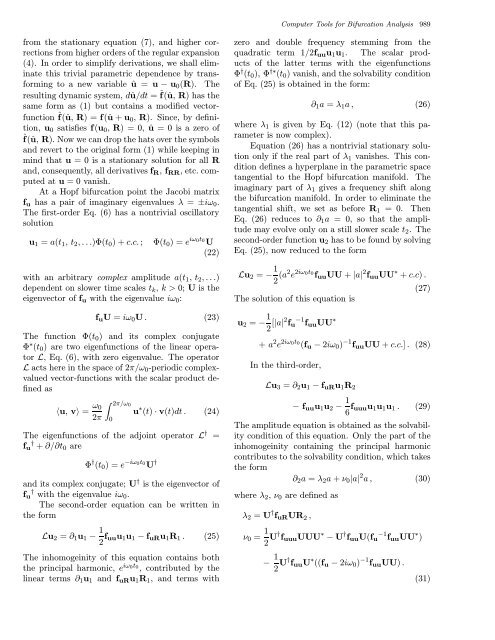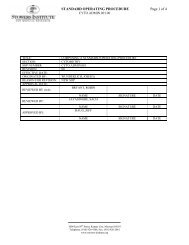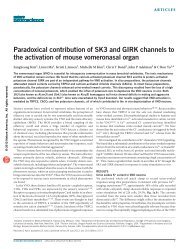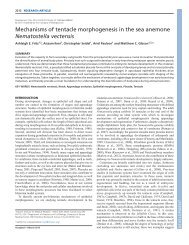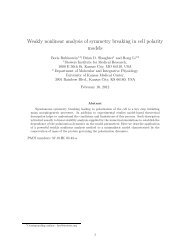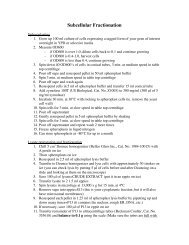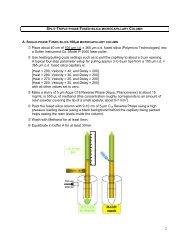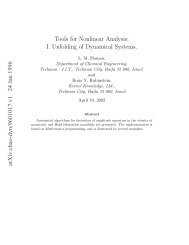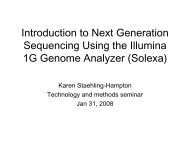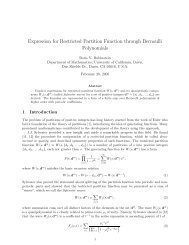Computer Tools for Bifurcation Analysis: General Approach with
Computer Tools for Bifurcation Analysis: General Approach with
Computer Tools for Bifurcation Analysis: General Approach with
Create successful ePaper yourself
Turn your PDF publications into a flip-book with our unique Google optimized e-Paper software.
<strong>Computer</strong> <strong>Tools</strong> <strong>for</strong> <strong>Bifurcation</strong> <strong>Analysis</strong> 989<br />
from the stationary equation (7), and higher corrections<br />
from higher orders of the regular expansion<br />
(4). In order to simplify derivations, we shall eliminate<br />
this trivial parametric dependence by trans<strong>for</strong>mingtoanewvariableû=u−u<br />
0 (R). The<br />
resulting dynamic system, dû/dt = ˆf(û, R) hasthe<br />
same <strong>for</strong>m as (1) but contains a modified vectorfunction<br />
ˆf(û, R) =f(û+u 0 ,R). Since, by definition,<br />
u 0 satisfies f(u 0 , R) =0,û= 0 is a zero of<br />
ˆf(û, R). Now we can drop the hats over the symbols<br />
and revert to the original <strong>for</strong>m (1) while keeping in<br />
mind that u = 0 is a stationary solution <strong>for</strong> all R<br />
and, consequently, all derivatives f R , f RR ,etc.computed<br />
at u = 0 vanish.<br />
At a Hopf bifurcation point the Jacobi matrix<br />
f u has a pair of imaginary eigenvalues λ = ±iω 0 .<br />
The first-order Eq. (6) has a nontrivial oscillatory<br />
solution<br />
u 1 = a(t 1 ,t 2 ,...)Φ(t 0 )+c.c. ;<br />
Φ(t 0 )=e iω 0t 0<br />
U<br />
(22)<br />
<strong>with</strong> an arbitrary complex amplitude a(t 1 ,t 2 ,...)<br />
dependent on slower time scales t k ,k>0; U is the<br />
eigenvector of f u <strong>with</strong> the eigenvalue iω 0 :<br />
f u U = iω 0 U . (23)<br />
The function Φ(t 0 ) and its complex conjugate<br />
Φ ∗ (t 0 ) are two eigenfunctions of the linear operator<br />
L, Eq. (6), <strong>with</strong> zero eigenvalue. The operator<br />
L acts here in the space of 2π/ω 0 -periodic complexvalued<br />
vector-functions <strong>with</strong> the scalar product defined<br />
as<br />
〈u, v〉 = ω ∫ 2π/ω0<br />
0<br />
u ∗ (t) · v(t)dt . (24)<br />
2π 0<br />
The eigenfunctions of the adjoint operator L † =<br />
f u † + ∂/∂t 0 are<br />
Φ † (t 0 )=e −iω 0t 0<br />
U †<br />
and its complex conjugate; U † is the eigenvector of<br />
f u † <strong>with</strong> the eigenvalue iω 0 .<br />
The second-order equation can be written in<br />
the <strong>for</strong>m<br />
Lu 2 = ∂ 1 u 1 − 1 2 f uuu 1 u 1 − f uR u 1 R 1 . (25)<br />
zero and double frequency stemming from the<br />
quadratic term 1/2f uu u 1 u 1 . The scalar products<br />
of the latter terms <strong>with</strong> the eigenfunctions<br />
Φ † (t 0 ), Φ †∗ (t 0 ) vanish, and the solvability condition<br />
of Eq. (25) is obtained in the <strong>for</strong>m:<br />
∂ 1 a = λ 1 a, (26)<br />
where λ 1 is given by Eq. (12) (note that this parameter<br />
is now complex).<br />
Equation (26) has a nontrivial stationary solution<br />
only if the real part of λ 1 vanishes. This condition<br />
defines a hyperplane in the parametric space<br />
tangential to the Hopf bifurcation manifold. The<br />
imaginary part of λ 1 gives a frequency shift along<br />
the bifurcation manifold. In order to eliminate the<br />
tangential shift, we set as be<strong>for</strong>e R 1 =0. Then<br />
Eq. (26) reduces to ∂ 1 a = 0, so that the amplitude<br />
may evolve only on a still slower scale t 2 .The<br />
second-order function u 2 has to be found by solving<br />
Eq. (25), now reduced to the <strong>for</strong>m<br />
Lu 2 = − 1 2 (a2 e 2iω 0t 0<br />
f uu UU + |a| 2 f uu UU ∗ + c.c) .<br />
(27)<br />
The solution of this equation is<br />
u 2 = − 1 2 [|a|2 f u −1 f uu UU ∗<br />
+ a 2 e 2iω 0t 0<br />
(f u − 2iω 0 ) −1 f uu UU + c.c.] . (28)<br />
In the third-order,<br />
Lu 3 = ∂ 2 u 1 − f uR u 1 R 2<br />
− f uu u 1 u 2 − 1 6 f uuuu 1 u 1 u 1 . (29)<br />
The amplitude equation is obtained as the solvability<br />
condition of this equation. Only the part of the<br />
inhomogeinity containing the principal harmonic<br />
contributes to the solvability condition, which takes<br />
the <strong>for</strong>m<br />
∂ 2 a = λ 2 a + ν 0 |a| 2 a, (30)<br />
where λ 2 ,ν 0 are defined as<br />
λ 2 = U † f uR UR 2 ,<br />
ν 0 = 1 2 U† f uuu UUU ∗ − U † f uu U(f u −1 f uu UU ∗ )<br />
The inhomogeinity of this equation contains both<br />
the principal harmonic, e iω 0t 0<br />
, contributed by the<br />
linear terms ∂ 1 u 1 and f uR u 1 R 1 , and terms <strong>with</strong><br />
− 1 2 U† f uu U ∗ ((f u − 2iω 0 ) −1 f uu UU) .<br />
(31)


